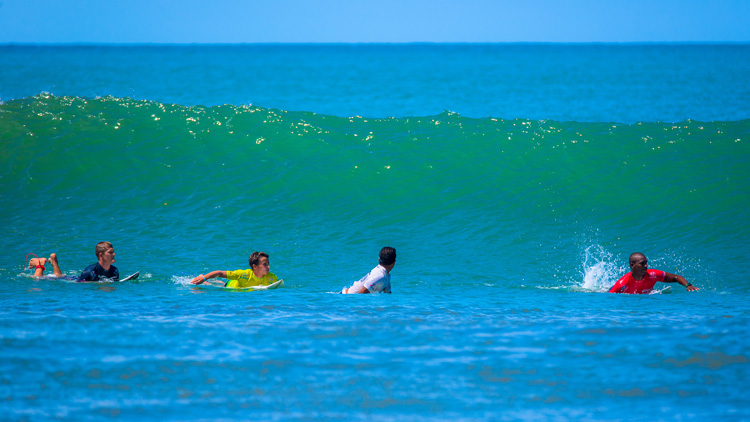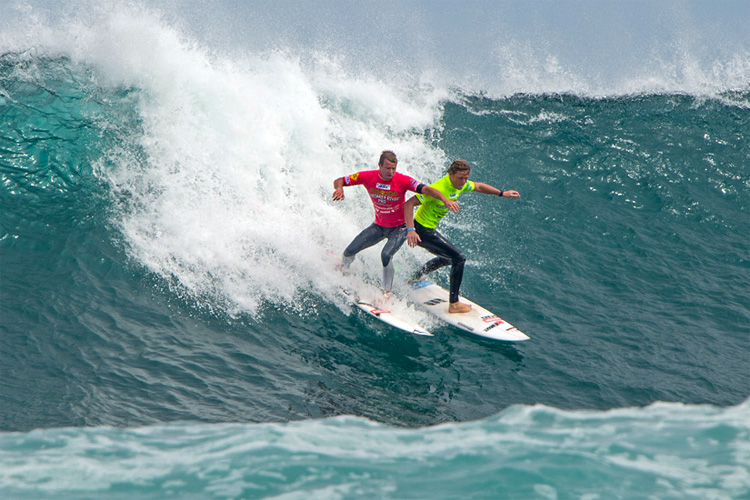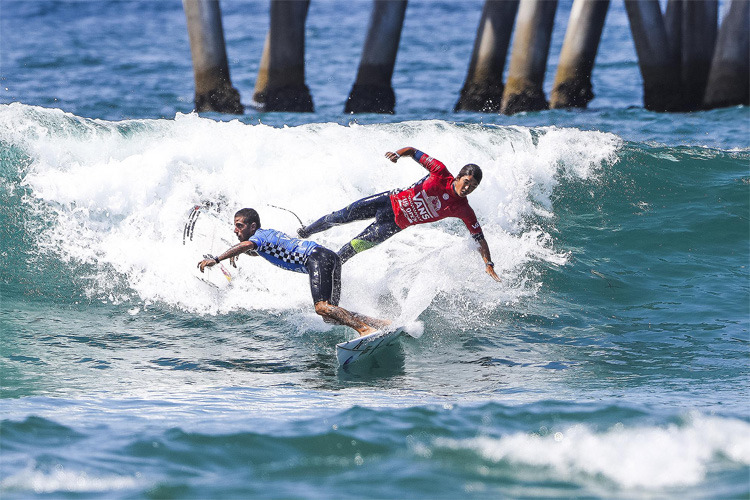Are you a pro surfer? Are you a passionate surf fan? Learn everything you need to know about interferences in pro surfing.
Professional surfing is a complex organized system in which surfers, but also judges, and third parties interact together in a competitive arena.
The World Surfing League (WSL) is responsible for running the annual tour of professional surf competitions.
The institution coordinates not only the popular Men's and Women's Championship Tour (CT) but also the Qualifying Series (QS), the Challenge Series (CS), the Longboard Tour (LT), and the Junior Tour (JT).
The majority of rules and regulations apply to all the above competitions. One of them is the interference rule.
The concept has been implemented for a long time now, but not everyone knows precisely how it works and applies in a heat.
So what is an interference in pro surfing? How does interference work?
An interference is called when a surfer hinders another surfer's ability to maximize their scoring potential while riding a wave under priority.
The WSL Rule Book has interesting (and curious) information about the subject.
For example, did you know that judges may not change their scores or interference calls either on the computer terminal or the manual judging sheets?
Whenever a mistake has been made, the judge should have the head judge make the correction for them.
And if a surfer stays in the competition area after two interference calls against him or her, he or she will have to pay a fine of $1,000 - tough stuff.
A double interference occurs when judges consider that two surfers share responsibility for the collision or other interference with each other.
For all WSL-sanctioned competitions, there are universal rules that apply evenly to all formats.
These are the most important ones:
1. Surfer Caddy Rules
If a caddy rides a wave, the surfer for whom they are caddying will be fined per wave.
And if the caddy interferes with other surfers in any way, interference will also be imposed on the surfer for whom he or she is caddying for.
The use of any equipment other than the surfboard - inflatable boats, jet skis, or caddies' surfboards - will be deemed an interference if the surfer, after using one of them, re-enters the competition zone and rides an extra wave or interferes with any other surfer by paddling or positioning.
2. Application of Interference and Priority Rules
An interference will only be called if the majority of the judges mark an interference on their judging sheet.

3. Interference Rules for Non-Priority
The surfer deemed to have the inside position for a wave has unconditional right of way for the entire duration of that ride.
Interference will be called if, during that ride, the majority of judges determine that a surfer hindered the scoring potential of the surfer deemed to have the right of way for that wave.
Anyone who stands up in front of a surfer with right of way has the chance to ride or kick out of the wave without being called interference unless they obstruct the scoring potential of the surfer with right of way by any means - excessive hassling, leash pulling or breaking down a section.
The surfer who remains in the water after their maximum number of waves will be penalized for interference if:
(a) A surfer rides any extra waves that obviously deprive another surfer of a ride;
(b) A surfer interferes with any other surfer by paddling, positioning, or some other reason;
4. Right of Way in Non-Priority Situations (Reef or Beach Break - Multiple Peak Situations)
If two surfers stand at the same time on two separate peaks that eventually meet, then if neither surfer gives way by exiting the ride and both share responsibility for the confrontation, then a double interference will be called.
Both surfers will be scored zero for that wave, and each of their second scoring waves will be cut in half.
5. Snaking
If the judges consider that the second surfer has interfered with the surfer with the right of way - by causing them to pull out or lose the wave - then interference may be called on the second surfer, even though they were behind the first when the penalty was called.
6. Paddling Interference
Paddling interference may be called if:
(a) The violating surfer makes contact with the inside surfer, hindering them, resulting in the surfer having to change their line while paddling to catch the wave, causing possible loss of scoring potential;
(b) The violating surfer obviously causes a section to break down in front of the inside surfer, which would not normally have done so, causing a loss of scoring potential;
When a surfer is put in a position while paddling out that they cannot get out of the way and a collision happens due to this, it is up to a majority of the Judges to call interference based on whether it is determined to be accidental or not.
7. Overlapping Heat Format
If there is deliberate unsportsmanlike interference by any surfer with either of the surfers in the other heat, the judges can call an interference penalty against the violating surfer, even if the surfer has unconditional priority.
The penalty will be the loss of half of their lowest-scoring ride.
8. Right of Way Using the Priority System
If a surfer gets an interference penalty, he/she will lose priority. The priority judge will determine the new priority position of the surfers in the heat.
9. General Priority Rules
A priority interference may be called individually by the head judge in case the majority of the judging panel does not see the incident.
Once a heat has ended, all priorities cease. If a surfer is riding a wave as the heat ends, they can't be interfered with by any surfer.
If an interference occurs, the violating surfer will get a priority situation interference.

The interference penalties are well defined in the WSL Rule Book:
a) In priority situations, when an interference is called on a surfer, the surfer's heat score will be calculated using only their best scoring wave;
b) In non-priority situations, when an interference is called on a surfer, the surfer's second-best scoring wave will be cut in half;
c) When an interference is called on a surfer while paddling to catch a wave or while riding a wave, the ride will be scored zero points;
d) Any interfering surfer must be penalized. Once the interference decision is made, it can only be modified by the head judge if they deem the decision was made relying on inaccurate technology (video/audio);
e) In non-priority heats, the surfer who suffered an interference will be allowed an additional wave beyond their wave maximum within the prescribed time limit. The only exception takes place when a double interference is called - in this case, neither surfer gets an extra wave;
f) If a surfer incurs in two interferences, he/she must immediately leave the competition area and:
- If both interferences are in a non-priority situation, both scoring rides will be halved;
- If one interference is in a non-priority situation and the other in a priority situation, one scoring ride will be halved, and the other scored a zero;
- If both interferences are in a priority situation, the surfer will be disqualified from the heat;
g) If neither surfer in an interference situation has established priority over the other surfer involved, the penalty will be a non-priority interference regardless of other surfers in the heat, hold priority or not, and the surfer's second-best scoring wave will be halved;
h) An interference can be called on a surfer with priority if, according to the priority or head judge, the surfer uses his/her priority in an unsportsmanlike manner to intentionally block another surfer with lower or no priority outside of the primary take-off zone;
i) If the discipline director and commissioner's office decide that an interference during a contest was intentional, unsportsmanlike, or of a serious nature, a surfer will lose the benefit of counting their best event result when calculating their ranking on tour;
